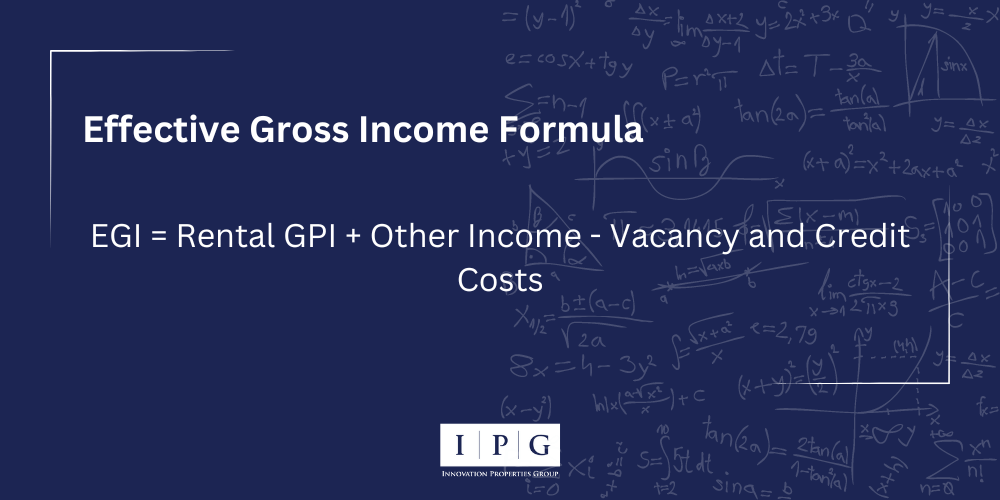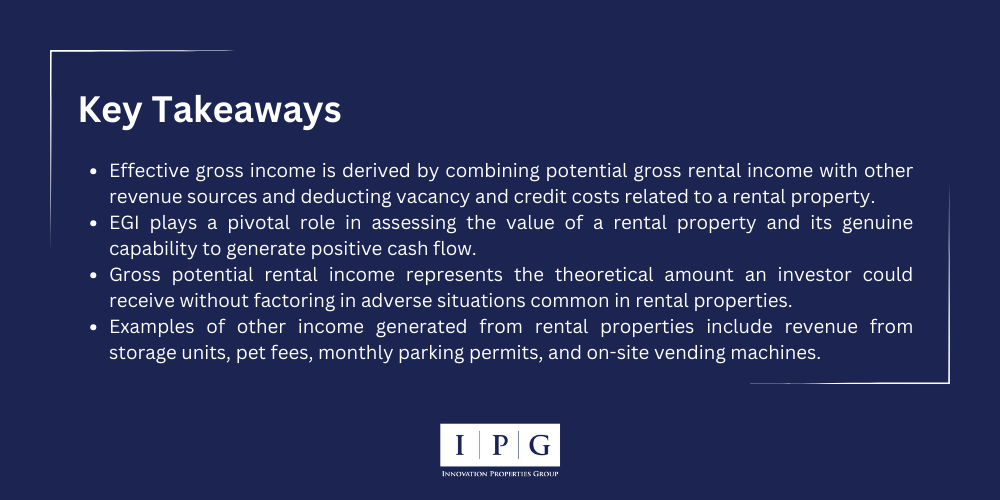Effective Gross Income (EGI): Definition, Formula and Example

Effective Gross Income (EGI) is a key metric for real estate investors to understand the true revenue potential of a rental property. By including all sources of income and accounting for vacancies and credit losses, EGI gives a clear picture of a property’s financial performance. In this blog post, we’ll explain what EGI is, how to calculate it, and provide a simple example to help you grasp its importance in real estate investing.
What Is EGI (Definition)?
Effective gross income is defined as the total income that a property can generate from its rentable spaces, factoring in various considerations such as vacancies and credit losses. In essence, EGI reflects the maximum attainable rental income before subtracting operating expenses like property taxes, insurance premiums, and maintenance costs.
By accounting for potential revenue streams while excluding certain operating expenses, EGI enables property owners, investors, and lenders to make informed decisions regarding investment strategies, property valuations, and financial projections.
Effective Gross Income Formula

Potential Gross Income (PGI) = Total Rental Income + Other Income
To figure out effective gross income, start by gathering all the info about how your rental property makes money. First, find the potential gross income, which is how much rent you could get if every unit was rented all the time.
Next, add up any extra income your property brings in, like parking fees or vending machine sales.
Then, subtract any money you expect to lose due to vacancies or tenants not paying their full rent. This is called a vacancy allowance for empty units and a bad debt allowance for unpaid rent.
Once you’ve subtracted those allowances, you’ve got your effective gross income.
Gross Potential Rental Income
This represents the theoretical rental income an investor would receive if the property were leased every day of the year at the agreed-upon rent specified in the lease. If the monthly rent is $2,000, the gross potential rental income would be $24,000 annually.
Other Income Generated by the Rental Property
This includes various revenue sources beyond standard rent payments, such as:
- Coin-operated laundry machines
- Vending machines
- Monthly parking permits
- Storage units
- Pet fees
- Late fees
Vacancy Costs
In real life, a unit will not always be rented for the entire year. Vacancy costs are the periods between tenants where the owner is not receiving rent because there is a “vacancy.” Vacancy costs are forecasts of how long the owner believes his unit will be without a tenant. If the owner has managed investment properties for some time, this cost may be estimated based upon his/her managerial experience or industry data.
Credit Costs
Credit costs will occur when a rental unit is occupied, and the owner does not receive the agreed-upon rental payment. The renter has not paid the rent, or has not paid it in its entirety. As with vacancy costs, this amount will be an estimate that may be based on historical data.
Effective Gross Income Calculation Example
Let’s consider a rental property with a monthly rent of $1,500. Additionally, the property generates income from laundry machines, parking bays, and vending machines, bringing in $3,500, $4,000, and $3,000 respectively, for the year. However, the property remained unoccupied for two months during the year. Here’s how the EGI is calculated:
- Potential Gross Income: $1,500 x 12 months = $18,000
- Other Income: $3,500 + $4,000 + $3,000 = $10,500
- Allowances for Bad Debts and Vacancies: $1,500 x 2 months = $3,000
The Effective Gross Income (EGI) would be ($18,000 + $10,500) – $3,000 = $25,500.
The Importance of EGI
Effective gross income is crucial in evaluating a property’s worth because it reveals the potential revenue after accounting for rentals, vacancies, and payment issues. Many real estate investors rely on a property’s net operating income (NOI) and cap rate to estimate a bidding price.
The bidding price is measured by dividing the NOI by the cap rate. To calculate the net operating income accurately, the EGI must be determined first, as it constitutes the revenue component of the NOI calculation. Therefore, conducting a precise EGI calculation is essential when evaluating a prospective property for purchase.

EGI vs NOI – What is The Difference?
Understanding effective gross income (EGI) is important for estimating a real estate property’s revenue potential because EGI forms part of the net operating income (NOI) calculation.
Net operating income (NOI) is widely regarded as a critical metric in the real estate industry and is relied upon by investors to make informed investment decisions.
NOI = Effective Gross Income (EGI) – Total Operating Expenses.
In this formula, the income component is represented by effective gross income (EGI), which accounts for vacancies and credit losses, rather than potential gross income.




